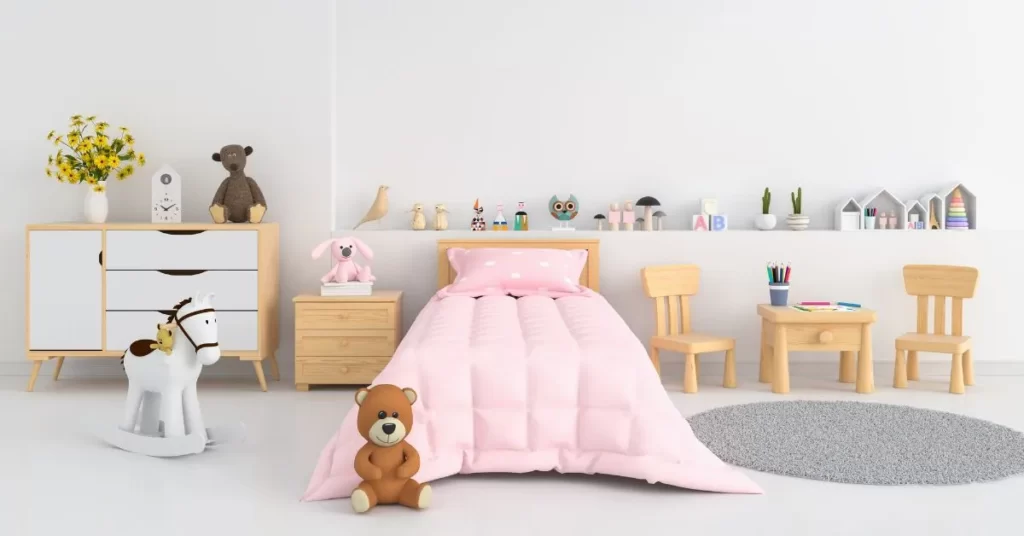Designing a kid’s room is an exciting endeavor. It’s an opportunity to create a space that fosters creativity, imagination, and growth while ensuring the utmost safety. One important aspect to consider during the design process is the standard dimensions of various elements within the room. From furniture to play areas, understanding the recommended measurements can help you create a playful and safe environment for your little ones. In this guide, we’ll explore the standard dimensions that will help you make informed decisions when designing your child’s room.

Kids’ Room Design: Create a Safe and Inspiring Space with Recommended Dimensions
Bed Dimensions:
The bed is the focal point of any kid’s room. When selecting a bed, it’s crucial to consider the size and age of your child. The standard dimensions for children’s beds are as follows:
- Toddler Bed: Toddler beds are designed for children aged 1 to 3 years. They typically measure around 27 inches wide and 52 inches long.
- Twin Bed: Twin beds are suitable for children aged 4 and above. They typically measure 39 inches wide and 75 inches long.
- Full Bed: Full beds provide more space for growing children and teenagers. They measure 54 inches wide and 75 inches long.
Desk Dimensions:
A desk is an essential addition to a kid’s room, providing a designated space for studying, drawing, and other activities. The recommended desk dimensions are:
- Height: The desk height should be around 22 to 30 inches, depending on the child’s age. This allows for comfortable seating and proper posture.
- Width: A desk width of 36 to 48 inches provides ample workspace for books, papers, and art supplies.
- Depth: A desk depth of 24 to 30 inches offers sufficient space for writing and other tasks.
Storage Solutions:
To keep the kid’s room organized and clutter-free, incorporating proper storage solutions is crucial. Consider the following dimensions for optimal storage:
- Bookshelf: The height of a bookshelf should be accessible to children, with the lower shelves starting around 18 inches from the ground. The width and depth can vary depending on available space and the number of books you wish to store.
- Toy Chest: A toy chest should have a height of around 16 to 20 inches, a width of 30 to 36 inches, and a depth of 16 to 18 inches. Ensure the lid has a safety mechanism to prevent accidental injuries.
- Closet: If your kid’s room has a closet, optimize its dimensions by installing adjustable shelves and hanging rods. Consider the height of the clothing rods to be within reach for your child.
Play Area Dimensions:
Creating a dedicated play area within the room encourages active play and imaginative games. The play area dimensions will depend on the available space, but it’s essential to provide enough room for movement. Consider the following recommendations:
- Clear Floor Space: Leave a minimum of 3 feet of clear floor space for unrestricted play and movement.
- Safety Mats: If you’re including play equipment like a slide or climbing wall, ensure there’s enough room around them, and consider placing safety mats or padded flooring to prevent injuries.
Designing a kid’s room involves careful consideration of standard dimensions to ensure a playful and safe environment. From beds and desks to storage solutions and play areas, understanding these dimensions will help you create a room that accommodates your child’s needs at different stages of their growth. Remember to keep the space functional, accessible, and age-appropriate to foster their development and creativity.
With this guide as your reference, you can embark on creating a delightful and safe haven for your little ones. By incorporating the recommended standard dimensions, you can ensure that the room is not only aesthetically pleasing but also functional and conducive to your child’s development.
Remember, safety should always be a top priority when designing a kid’s room. In addition to the dimensions mentioned above, here are a few additional safety considerations to keep in mind:
- Electrical Outlets:
Install childproof outlet covers or consider placing furniture strategically to block access to electrical outlets. This will prevent any accidents or injuries caused by curious little hands. - Window Treatments:
Use cordless blinds or install window cord safety devices to eliminate the risk of strangulation. Make sure curtain rods are securely mounted to avoid any accidents. - Furniture Stability:
Anchor heavy furniture such as dressers, bookshelves, or cabinets to the wall to prevent tipping. This is especially important if your child is prone to climbing or exploring. - Rounded Edges:
Opt for furniture with rounded edges to minimize the risk of injuries from sharp corners. If you already have furniture with sharp edges, consider using corner guards or cushions to soften them. - Non-Toxic Materials:
When selecting furniture, bedding, and other room accessories, choose non-toxic materials that are safe for children. Look for certifications such as Greenguard or Oeko-Tex Standard 100 to ensure that the products meet stringent safety standards.
Remember, these are general recommendations, and it’s important to adapt them to your specific space and the needs of your child. Take into account their age, preferences, and any specific requirements they may have.
Conclusion
In conclusion, designing a kid’s room involves careful attention to standard dimensions to create a playful and safe environment. From beds and desks to storage solutions and play areas, incorporating the appropriate measurements ensures that the room meets your child’s needs at various stages of their growth. By prioritizing safety and considering the guidelines mentioned in this guide, you can create a space that nurtures their imagination, encourages their development, and provides a secure haven for them to explore, learn, and play.












